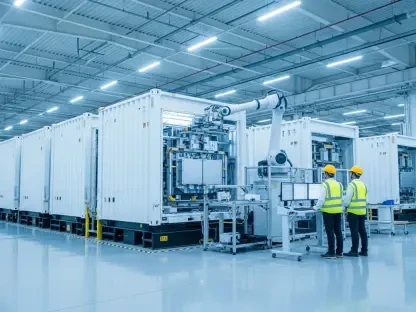As the impacts of climate change become more pronounced and there is a growing demand from stakeholders and consumers for sustainable practices, the realm of information technology stands at a crucial juncture. IT departments and professionals have a unique opportunity to enhance sustainability in their operations. This article delves into actionable steps that IT departments can adopt to drive sustainability in 2025.
Improve Energy Efficiency in Data Centers
Improving energy efficiency in data centers is crucial for reducing operational costs and minimizing the environmental impact of these facilities. By implementing energy-efficient technologies and practices, data centers can significantly cut down on energy consumption. This includes optimizing cooling systems, using energy-efficient servers and equipment, and adopting advanced power management strategies. Additionally, incorporating renewable energy sources like solar and wind power can further enhance the sustainability of data centers. Energy efficiency improvements not only benefit the bottom line but also contribute to the overall reduction of carbon footprints, aligning with global efforts to combat climate change.
Reducing Energy Consumption
Data centers are critical to the digital infrastructure of various sectors, including businesses, governments, and educational institutions. The increasing demand placed on data centers due to factors like social media, video streaming, smart technologies, electric vehicles, and artificial intelligence has led to significant energy consumption. This growing demand has underscored the necessity for IT teams to focus on reducing energy consumption, lowering costs, and meeting environmental benchmarks. By doing so, they can address the challenges posed by high energy usage and its associated environmental impact.
To achieve these goals, IT departments must embrace strategies designed to improve energy efficiency. One such approach involves server consolidation, which reduces underutilization by using fewer servers more effectively. This technique helps optimize the use of technological resources, ultimately lowering energy consumption. Adopting energy-efficient hardware is equally important; incorporating lower power-consuming servers, networking technologies, and storage solutions can significantly diminish energy usage while maintaining performance standards.
Server Consolidation and Energy-Efficient Hardware
Server consolidation is a key strategy in the sustainable operation of data centers. By using fewer servers, IT departments can reduce the underutilization of resources and make better use of existing technology. This approach not only helps in cutting down on energy consumption but also results in cost savings. Additionally, the adoption of energy-efficient hardware plays a pivotal role in achieving sustainability goals. Implementing lower power-consuming servers, networking equipment, and storage solutions can substantially reduce energy use while maintaining the required performance levels.
Another crucial aspect of energy efficiency is the use of monitoring software. These tools enable IT departments to track power usage in real-time, allowing them to optimize the performance and efficiency of their setups. By identifying areas where energy is being wasted, IT teams can make informed decisions on improvements and adjustments. Moreover, investing in renewable energy sources, such as solar panels and wind turbines, can further enhance the sustainability of data centers by reducing their carbon footprint and reliance on non-renewable energy sources.
Renewable Energy and Energy-Saving Lighting
Integrating renewable energy sources in data centers can have a profound impact on their carbon footprint. Solar panels and wind turbines are excellent examples of renewable energy technologies that can be used to power data centers. By harnessing the power of the sun and wind, IT departments can significantly decrease their reliance on fossil fuels and reduce greenhouse gas emissions. Additionally, implementing energy-saving lighting solutions, such as light-emitting diode (LED) bulbs, can further enhance the sustainability of data centers by reducing energy consumption for lighting.
A proactive maintenance schedule is also essential for ensuring the longevity and efficiency of data center equipment. Regularly checking equipment performance and making necessary improvements can prolong the lifespan of devices, thereby reducing the need for frequent replacements. This not only helps in reducing energy consumption but also minimizes the environmental impact associated with manufacturing and disposing of electronic equipment. By adopting these practices, IT departments can contribute significantly to a more sustainable and environmentally-friendly future.
Establish a Circular Economy
Addressing Electronic Waste
The globe generated a staggering 62 million metric tons of electronic waste (e-waste) in 2022, marking an 82% increase since 2010, highlighting an escalating environmental concern. Alarmingly, only 22.3% of this e-waste was recycled properly, representing a missed opportunity to recover valuable raw materials and minimize environmental impact. E-waste poses severe environmental risks, harming ecosystems and exposing humans to hazardous substances like mercury, lead, and cadmium, underscoring the urgency of addressing this issue within IT practices.
Establishing a circular economy is a strategic approach to tackle the growing problem of e-waste. This concept promotes the repairability, reusability, and recyclability of all technological equipment, aiming to maximize the lifecycle of products and reduce waste. Creating an inventory of IT equipment nearing the end of its life cycle and assessing its potential for repair or repurposing is a crucial step. By doing so, IT departments can identify opportunities to refurbish or upgrade existing devices, thereby extending their lifespan and reducing the need for new purchases.
Promoting Repairability and Reusability
Promoting repairability and reusability within IT departments can significantly contribute to a circular economy. Extending the lifespan of old equipment through refurbishing or donating it to nonprofits and schools not only aids in reducing e-waste but also supports social initiatives. By refurbishing outdated devices, IT departments can provide valuable technology to underserved communities, fostering digital inclusion while simultaneously addressing environmental concerns. Encouraging a culture of repairability within the organization can also lead to reduced costs and more efficient use of resources.
Additionally, ensuring that recyclers comply with environmental regulations concerning e-waste disposal is essential for maintaining a sustainable practice. Partnering with reputable service providers guarantees that end-of-life equipment is disposed of properly, minimizing environmental harm. IT departments must stay informed about evolving compliance standards at city, state, and federal levels to ensure adherence to the latest regulations. Maintaining detailed records of recycled equipment, including descriptions and disposal methods, fosters transparency and accountability in e-waste management practices.
Ensuring Proper Disposal and Compliance
Ensuring proper disposal and compliance with environmental regulations is a critical aspect of managing electronic waste. It involves partnering with reputable service providers who adhere to the best practices for e-waste disposal, thereby minimizing harm to the environment. By working with certified recyclers, IT departments can ensure that hazardous substances such as mercury, lead, and cadmium are handled and disposed of safely. This practice not only protects the environment but also helps recover valuable raw materials that can be reused in manufacturing new devices.
Maintaining accurate records of recycled equipment is also essential for ensuring transparency and accountability in e-waste management. Detailed descriptions and disposal methods of each piece of equipment should be documented to track the lifecycle of electronic devices. This information can be used to demonstrate compliance with environmental regulations and to share with stakeholders information about the organization’s sustainability efforts. By keeping abreast of evolving compliance standards at various governmental levels, IT departments can stay ahead of regulatory changes and continuously improve their e-waste management practices.
Transition to Digital Documentation
Recognizing the myriad benefits of digital documentation, many organizations are gradually shifting away from traditional paper-based systems. This transition enhances efficiency, accessibility, and sustainability while reducing the risks associated with physical document storage. Embracing digital documentation not only streamlines workflows but also supports environmental initiatives by decreasing paper usage.
Benefits of Cloud Solutions
Transitioning to digital documentation is an essential step for IT departments aiming to enhance sustainability. In an era where data security and accessibility are paramount, cloud solutions offer a reliable and efficient way to store essential files. These platforms not only provide secure storage but also enhance collaboration and facilitate easier file sharing among team members, regardless of their physical location. By leveraging cloud technology, IT departments can protect valuable documents during unforeseen downtimes, ensuring business continuity and operational resilience.
The cost-saving benefits of adopting cloud solutions are also significant. By moving to cloud-based storage, IT teams can potentially save up to 20% in spending by reducing maintenance costs and the need for physical servers. This shift eliminates the expenses associated with maintaining on-premises infrastructure, such as hardware upgrades, cooling systems, and physical space. Furthermore, cloud solutions offer scalable storage options that can grow with the organization’s needs, providing flexibility and efficiency in data management.
Reducing Paper Waste
Reducing paper waste is essential for conserving natural resources and protecting the environment. By implementing simple practices such as recycling, using digital documents, and printing double-sided, individuals and organizations can significantly reduce their paper consumption.
Reducing paper waste through the adoption of digital documentation is another crucial aspect of sustainable IT practices. By transitioning to electronic document management systems, organizations can significantly decrease their reliance on paper, thereby reducing deforestation and the environmental impact associated with paper production. Implementing electronic signatures is an effective method for digitizing document workflows, enabling faster and more efficient processing of agreements and contracts without the need for physical paperwork.
The shift to digital documentation also offers several operational benefits. It streamlines document management processes, making it easier to organize, retrieve, and share information. This increased efficiency can lead to improved productivity and reduced administrative burdens for IT departments. Additionally, digital documents can be stored and backed up in multiple locations, ensuring data redundancy and protection against loss. By embracing digital documentation, IT departments can contribute to a more sustainable future while enhancing their operational capabilities.
Deploy Tracking and Reporting Tools
To ensure optimal performance and accountability, deploying tracking and reporting tools is essential for any project. These tools provide real-time data and insights, enabling teams to monitor progress, identify bottlenecks, and make informed decisions.
Utilizing AI and IoT Technologies
Leveraging advancements in artificial intelligence (AI) and the Internet of Things (IoT) can significantly enhance the sustainability efforts of IT departments. Numerous AI-powered tools have been developed to help IT teams track and report their energy usage, providing valuable insights into consumption patterns and areas for improvement. These tools enable organizations to make data-driven decisions to optimize their energy use and reduce their carbon footprint. By identifying inefficiencies and implementing targeted strategies, IT departments can achieve substantial energy savings and contribute to environmental conservation.
IoT technologies play a crucial role in this process by enabling devices to collect and transfer large volumes of data. Within IT functions and workspaces, IoT sensors can monitor various parameters, such as energy usage, temperature, and lighting conditions. This real-time data collection allows for continuous monitoring and analysis, uncovering opportunities for optimization and automation. For instance, IoT-enabled smart lighting systems can adjust brightness levels based on occupancy and natural light, reducing energy consumption without compromising comfort and productivity.
Optimizing Energy Usage
Optimizing energy usage through continuous monitoring and analysis is a key component of sustainable IT operations. By collecting data on energy consumption, IT departments can identify patterns and trends that reveal areas for improvement. This information can be used to implement more efficient practices, such as adjusting HVAC systems for enhanced indoor comfort or optimizing lighting systems to reduce unnecessary energy use. Additionally, AI-powered tools can provide predictive analytics, helping organizations anticipate and mitigate potential energy inefficiencies before they become significant issues.
Monitoring tools also facilitate goal-setting and progress tracking, enabling IT departments to set realistic sustainability targets and measure their achievements over time. These tools provide a clear picture of how well teams are advancing toward their sustainability goals, allowing for adjustments and improvements as needed. Moreover, the ability to communicate environmental achievements to other departments, corporate leadership, and stakeholders is invaluable. It demonstrates the organization’s commitment to sustainability and fosters a culture of environmental responsibility across the business.
Allow Remote Work and Telecommuting
Environmental Benefits of Remote Work
Remote work offers several environmental benefits, including a reduction in greenhouse gas emissions due to fewer commuting vehicles on the roads. This not only decreases air pollution but also lessens the overall carbon footprint. Furthermore, remote work can lead to less waste as employees are more likely to use digital documents rather than paper. Additionally, energy consumption in large office buildings is reduced, contributing to a more sustainable environment. The shift to remote work has also prompted companies to invest in eco-friendly practices and technologies, further highlighting its positive impact on the environment.
The COVID-19 pandemic has undeniably transformed business operations, with one of the most significant changes being the shift towards remote work. This transformation holds substantial environmental benefits, particularly in reducing transportation emissions. Remote work eliminates the need for daily commutes, which significantly lowers the carbon footprint associated with personal vehicles and public transportation. With IT positions expected to represent 10% of the jobs anticipated to go remote by 2030, the potential impact on reducing emissions is considerable.
A study highlighted a potential reduction in U.S. carbon emissions by 191.8 million metric tons if 10% fewer individuals commute by car or public transportation. This decrease in emissions not only contributes to environmental preservation but also aligns with global efforts to combat climate change. The environmental benefits of remote work extend beyond transportation emissions, as it also reduces the energy consumption associated with operating office spaces. Fewer employees commuting means less demand for office heating, cooling, and lighting, further contributing to sustainability goals.
Addressing Potential Challenges
While the environmental benefits of remote work are clear, IT departments must also address potential challenges that accompany this transition. One significant concern is the potential revenue losses for public transport systems, estimated at $3.7 billion. As fewer individuals utilize public transportation, the funding and sustainability of these systems may be impacted. IT departments and organizations must consider these implications and explore ways to support public transportation in the evolving work landscape.
Another challenge is ensuring that remote work arrangements do not compromise IT security and data integrity. With employees accessing company resources from various locations, it is essential to implement robust cybersecurity measures to protect sensitive information. IT departments must provide secure remote access solutions, such as virtual private networks (VPNs), and ensure that employees are trained in best practices for maintaining data security. Additionally, fostering a culture of collaboration and maintaining team cohesion in a remote work environment requires thoughtful planning and the use of effective communication tools.
Offer Sustainability Training for IT Employees
Building an Eco-Conscious IT Workforce
Building an eco-conscious IT workforce is critical for advancing sustainability goals within an organization. Training IT employees on sustainable practices, such as conserving power, lowering the company’s digital footprint, and recycling equipment properly, plays a pivotal role in fostering an environmentally responsible culture. By equipping employees with the knowledge and tools to implement sustainable practices, IT departments can drive meaningful change and achieve their sustainability objectives.
Offering practical tips for individuals to save energy during their daily activities can make sustainability practices more compelling and attainable within the workplace. For instance, employees can be encouraged to adjust their computer settings for energy efficiency, unplug devices when not in use, and participate in recycling programs. Additionally, promoting awareness about the environmental impact of IT operations can motivate employees to adopt more sustainable habits both at work and in their personal lives.
Soliciting Feedback and Tailoring Programs
Soliciting suggestions and feedback from employees regarding training content is vital for creating effective and engaging sustainability programs. IT directors should actively seek input from their teams to understand their perspectives and identify areas where additional training or resources may be needed. By tailoring training programs to address specific needs and interests, IT departments can foster a sense of ownership and collaboration among employees, encouraging them to actively participate in sustainability initiatives.
Moreover, ongoing education and training are essential for keeping pace with evolving sustainability practices and technologies. IT departments should regularly update their training modules to reflect the latest advancements and best practices in environmental sustainability. Offering opportunities for professional development, such as workshops, seminars, and certification programs, can further enhance employees’ knowledge and skills. By investing in sustainability training, IT departments can build a workforce that is not only well-informed but also passionate about contributing to a more sustainable future.
Creating a Greener Digital Landscape in 2025
As the impacts of climate change intensify and stakeholders, including consumers, increasingly demand sustainable practices, the information technology sector finds itself at a pivotal moment. IT departments and experts have a unique chance to contribute significantly to sustainability within their operations. This piece explores actionable strategies that IT departments can implement to promote sustainability by 2025. These initiatives not only help in reducing the environmental footprint but also align with broader corporate sustainability goals. Key measures include optimizing energy consumption, adopting greener technologies, and integrating sustainable practices into daily operations. Additionally, IT departments can advocate for the use of renewable energy sources, improve waste management practices, and encourage the transition to energy-efficient hardware and software solutions. By embracing these steps, IT professionals can lead the charge in making their organizations more environmentally responsible, setting a benchmark for other sectors to follow.









